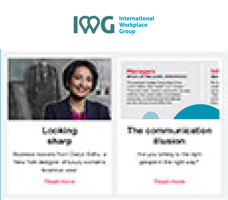Hybrid working is transforming workplace wellness, with a corresponding rise in productivity. With burnout in the spotlight, a solution is already here – so how does hybrid help wellbeing?
With workplace wellness in the spotlight more than ever, new research published by IWG offers a compelling solution to the burnout problem we wrote about last month. By freeing workers from the stress of commuting and giving them more time to live a healthier lifestyle, the research indicates that the hybrid working model spells better wellbeing on just about every level. Here’s why…
The wellbeing benefits of hybrid
IWG’s survey of 2,000 hybrid workers found that, on average, they’re exercising nearly 90 minutes a week longer than they were before the pandemic, with nearly a quarter having lost more than 10kg in weight. Not only that; they’re enjoying healthier diets, and getting an extra 71 hours of sleep a year thanks to the reduced time spent commuting.
Simultaneously, there’s a corresponding rise in productivity among hybrid workers, with 79% saying they’re now more productive thanks to less work-related stress (47%) and having more time to relax and unwind after work (46%). This double win has a favourable knock-on effect on their mental health, with two thirds feeling that their mental health is good as a result of the shift to hybrid working.
World-renowned healthcare professional Dr Sara Kayat is a passionate advocate of the benefits of an active and healthy lifestyle, and she’s partnered with IWG to examine the health advantages of hybrid working. “There is no doubt that hybrid working has facilitated some major health benefits,” she comments. “A balanced diet, physical activity and good quality sleep are the bedrocks of a healthy lifestyle, and this data suggests that each is more widespread due to the extra time afforded by a hybrid working model.”
“Stress management and social connections are also incredibly important to mental wellbeing,” she adds. “A healthy work-life balance is essential to achieving these, allowing people to work closer to home and make more time for family, friends and stress-busting hobbies.”
The burnout backdrop – and the solution
According to a new study from Slack, burnout rates rose 8% among the global workforce between May and August last year, which reinforces the findings from IWG's research. Hybrid working promotes worker engagement and wellbeing, and is therefore an effective solution to burnout.
As IWG CEO Mark Dixon says in the white paper: “This study confirms what we have been seeing for a while now – how hybrid working is building and maintaining a healthier and happier workforce by reducing the need for long daily commutes.”
“Offering hybrid working is such an important and easy way for businesses to put their employees first by freeing up their time and giving them greater control over their schedules,” he continues. “Organisations that have adopted hybrid working are not only seeing healthier and happier workforces, but more engaged and productive teams.”
That’s good news for workers and employers alike, and there’s an added bonus: it’s also a positive development for companies looking to ‘walk the walk’ when it comes to sustainability. ‘Good Health and Wellbeing’ is the third of the United Nations’ 17 Sustainable Development Goals for 2030, and supporting it is simple: go hybrid, and you embrace a way of working that has the welfare of people, business and the planet at its heart.
Discover how IWG can help your company transform workplace wellness with hybrid, with advice on your workplace strategy and access to 3,500 flexible workspaces worldwide.






